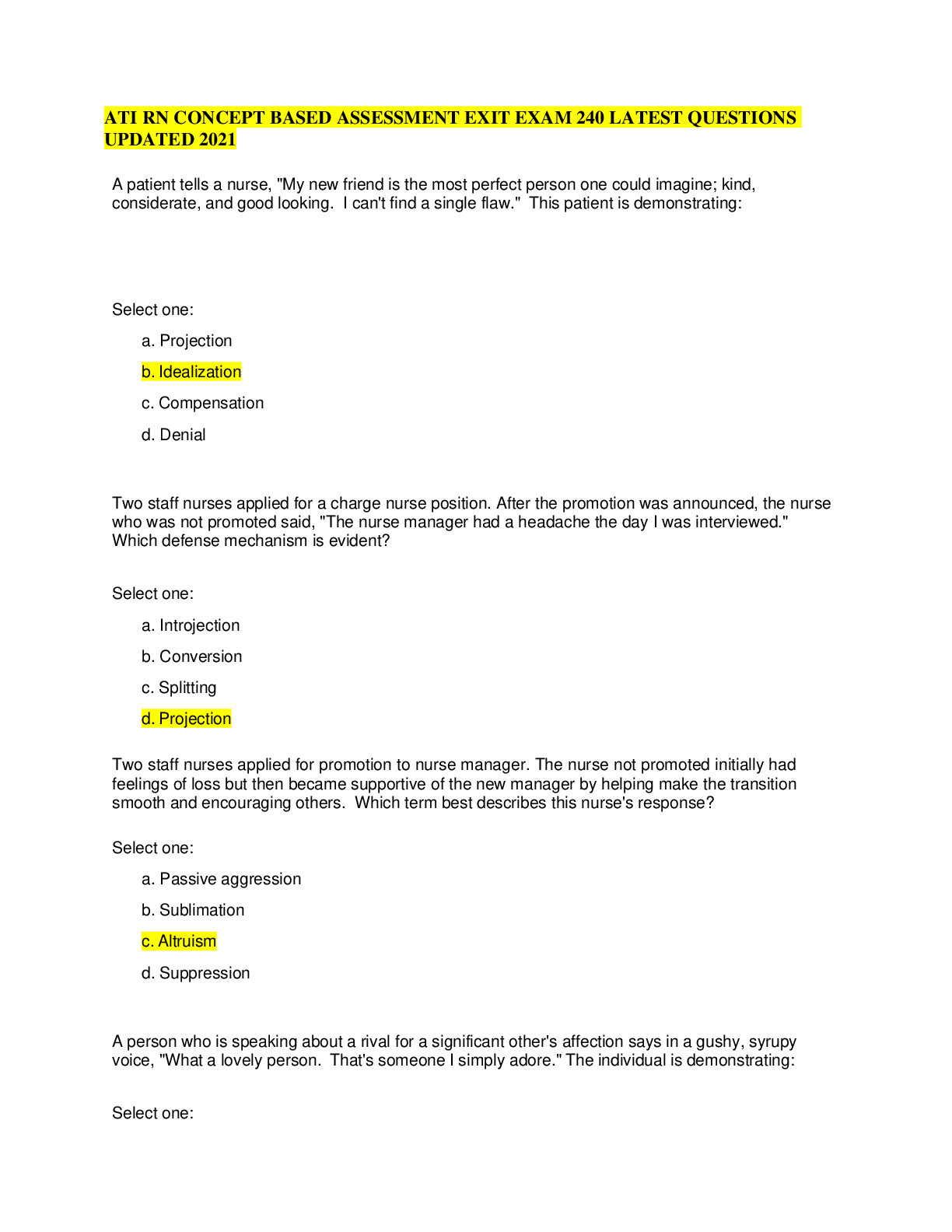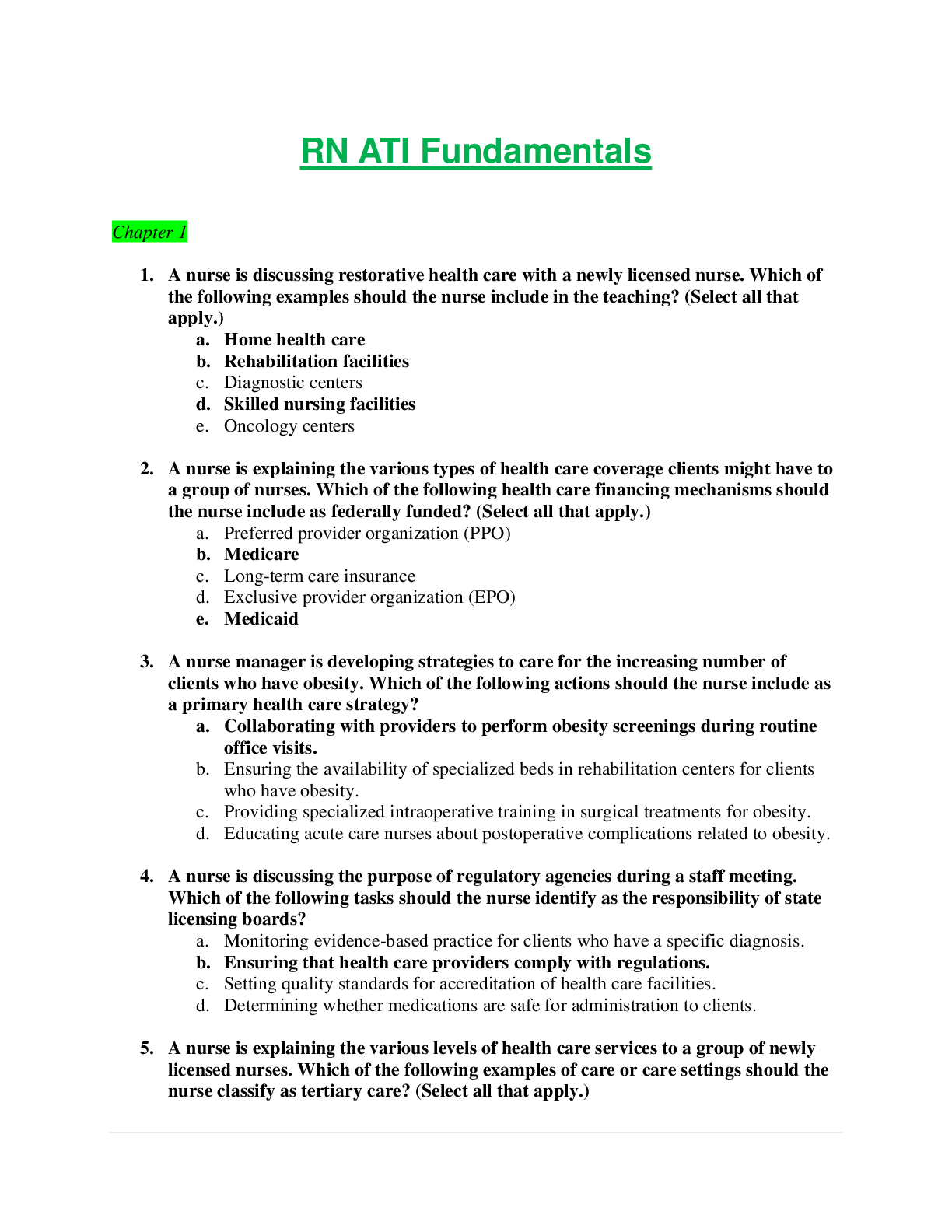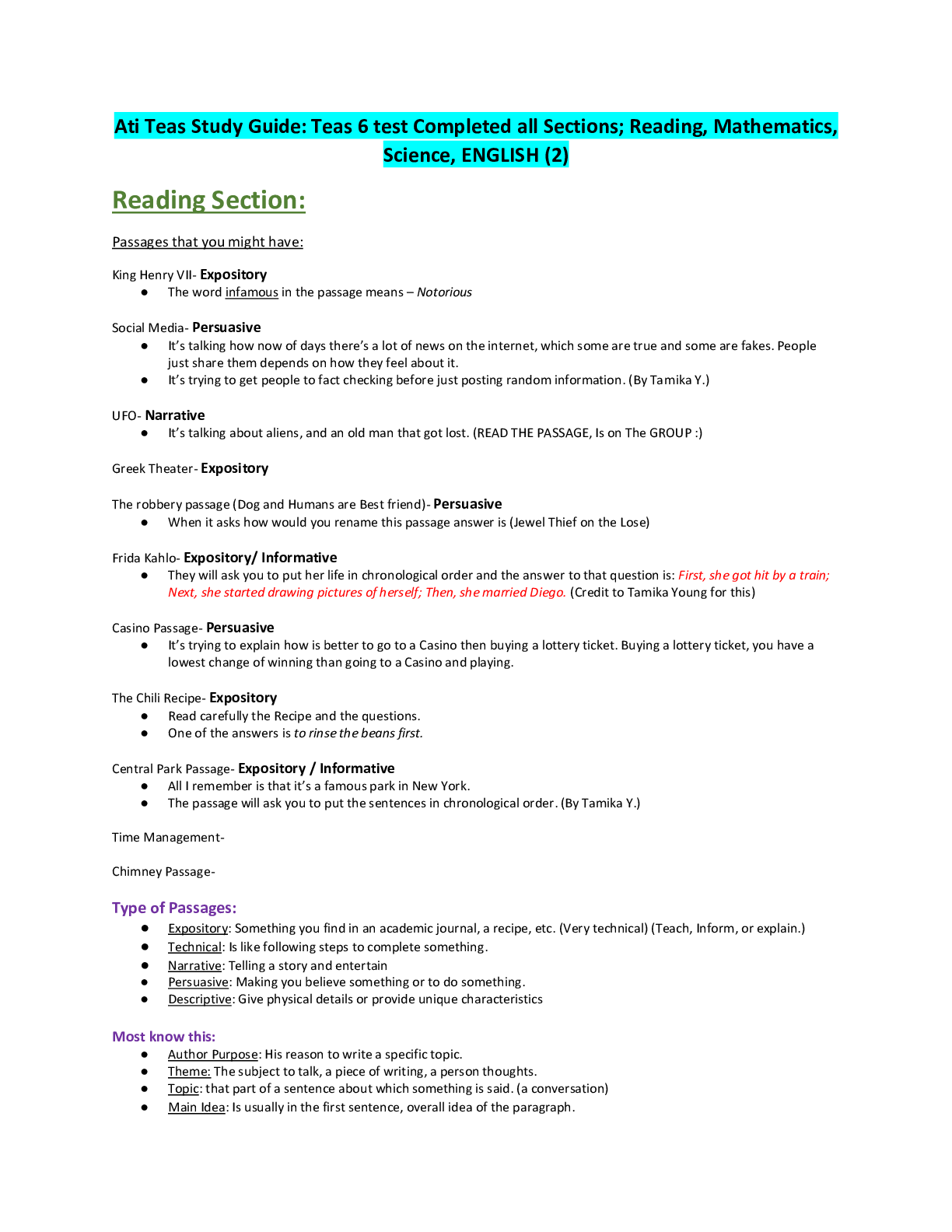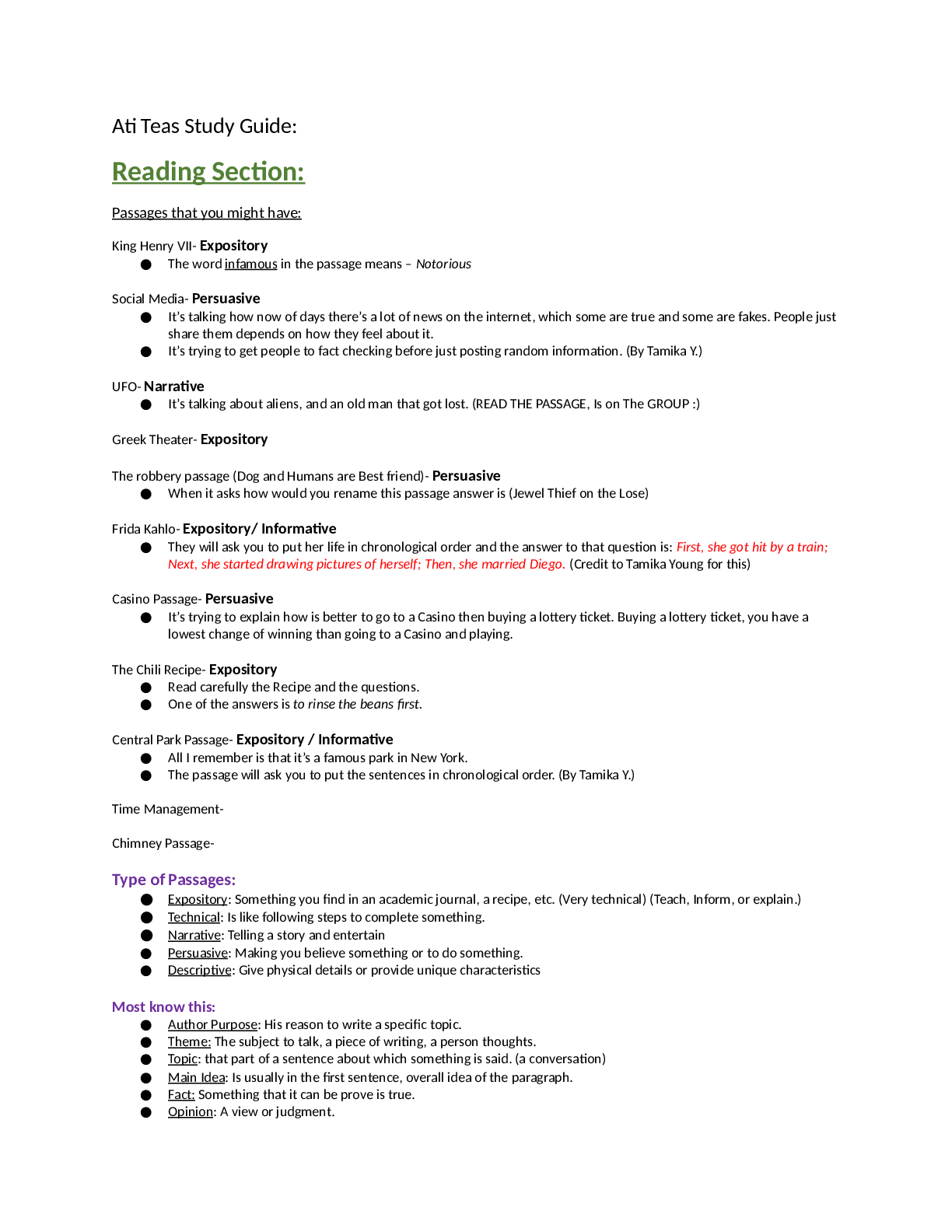*NURSING > QUESTIONS and ANSWERS > NSG 6020 GI REVIEW QUESTIONS LATEST UPDATE 2020 WITH COMPLETE SOLUTION (All)
NSG 6020 GI REVIEW QUESTIONS LATEST UPDATE 2020 WITH COMPLETE SOLUTION
Document Content and Description Below
You examine a 59-year-old man with a chief complain of new onset rectal pain after a bout of constipation. On examination, you note an ulcerated lesion on the posterior midline of the anus. This prese... ntation is most consistent with: A. perianal fistula B. anal fissure C. external hemorrhoid D. Crohn proctitis In anal fissure, there is an ulcer or tear of the margin of the anus. Most fissures occur posteriorly. Risk factors include constipation, diarrhea, recent childbirth, and anal intercourse or other anal insertion practices. The best treatment practices for anal fissures is avoidance of the condition through adequate fiber and fluid intake, avoiding constipation, and minimizing or eliminating activity that triggers or contributes to the condition. Rectal bleeding associated with hemorrhoids is usually described as: A. streaks of bright red blood on the stool. B. dark brown to black in color and mixed in with normal appearing stool. C. a large amount of brisk red bleeding. D. significant blood clots and mucous mixed with stool. The superior hemorrhoidal veins form internal hemorrhoids, wheras the inferior hemorrhoidal veins form external hemorrhoids. Both forms are normal anatomical findingsbut cause discomfort when there is an increase in the venous pressure and reulting dilation and inflammation, such as in childbirth, obesity, constipation, and prolonged sitting. Over time, tissue and vessel redundancy develop, resulting in rectal protrusion and increased risk for bleeding. With chronically protruding or prolapsing hemorrhoids, the pt often reports itching, mucous leaking, and staining of undergarments with streaks of stool. Manual reduction of the protruding hemorrhoid after evacuation can be helpful. Therapy for hemorrhoids includes all of the following except: A. weight control. B. low-fat diet. C. topical corticosteroids. D. the use of a stool softner. As with anal fissure, prevention of hemorrhoidal engorgement and inflammation is the best treatment. Strategies include weight control, high-fiber diet, regular exercise, and increased fluid intake. Treatment for acute hemorrhoid flare ups includes the use of astringents and topical corticosteroids, sitz baths, and analgesics. Surgical intervention is warranted with more conservative therapy fails to yield clinical improvement.These therapies are also used to treat pt's with anal fissure. All of the following are typically noted in a young adult with the diagnosis of acute appendicitis except: A. epigastric pain. B. positive obturator sign. C. rebound tenderness. D. marked febrile response. A 26 year old man presents with acute abdominal pain. As part of the evaluation for acute appendicitis, you order a white blood cell (WBC) count with differential and anticipate the following results: A. total WBCs, 4500 mm3; neutrophils, 35%; bands, 2%; lymphocytes, 45% B. total WBCs, 14,000 mm3; neutrophils, 55%; bands, 3%; lymphocytes, 38% C. total WBCs, 16,500 mm3; neutrophils; 66%; bands, 8%; lymphocytes, 22% D. total WBCs, 18,100 mm3; neutrophils, 55%; bands, 3%; lymphocytes, 28% In evaluating a patient with suspected appendicitis, the clinician considers that: A. the presentation may differ according to the anatomical location of the appendix. B. this is a common reason for acute abdominal pain in elderly patients. C. vomiting before the onset of abdominal pain is often seen. D. the presentation is markedly different from the presentation of pelvic inflammatory disease. There is no true classic presentation of acute appendicitis. Vague epigastric or periumbilical pain often heralds its beginning.The psoas sign can be best described as abdominal pain elicited by: A. passive extension of the hip. B. passive flexion and internal rotation of the hip. C. deep palpation. D. asking the patient to cough. The obturator sign can be best described as abdominal pain elicited by: A. passive extension of the hip. B. passive flexion and internal rotation of the hip. C. deep palpation. D. asking the patient to cough. To support the diagnosis of acute appendicitis with suspected appendiceal rupture, you consider obtaining the following abdominal imaging study: A. magnetic resonance image. B. computed tomography (CT) scan. C. ultrasound. D. flat plate. Which of the following WBC forms is an ominous finding in the presence of severe bacterial infection? A. neutrophil B. lymphocyte C. basophil D. metamyelocyte Myelocytes and metamyelocytes are immature neutrophil forms that are typically found in only the granulopoiesis pool. The presence of thses cells is an ominous marker of life-threatening infection, and these are occasionally found in the presence of appendiceal rupture. Which of the following best represents the peak ages for occurrence of acute appendicitis? A. 1 to 20 years B. 20 to 40 years C. 10 to 30 years D. 30 to 50 years. The peak age of patients with acute appendicitis is 10 to 30 years; this condition is uncommon in infants and elderly adults. At either end of the life span, a delay in diagnosis of appendicitis commonly occurs because providers do not consider appendicitis a possibility. Clinical findings most consistent with appendiceal rupture include all of the following except: A. abdominal discomfort less than 24 hours in duration. B. fever greater than 102 F (> 38 C) C. palpable abdominal mass. D. marked leukocytosis with total WBC greater than 20,000/mm3. A 43 year old woman has a 12 hour history of sudden onset of right upper quadrant abdominal pain with radiation to the shoulder, fever, and chills. She has had similar, milder episodes in the past. Examination reveals marked tenderness to right upper quadrant abdominal palpation. Her most likely diagnosis is: A. hepatoma. B. acute chlolecystitis C. acute hepatitis D. cholelithiasis White of the following is usually not seen in the diagnosis of acute cholecystitis? A. elevated lactic dehydrogenase level. B. increased alkaline phosphatase level. C. leukocytosis. D. elevated aspartate aminotransferase (AST) level Murphy's sign can be best described as abdominal pain elicited by: A. right upper quadrant abdominal palpation B. asking the patient to stand on tiptoes and then letting body weight fall quickly onto the heels. C. asking the patient to cough. D. percussion. Risk factors for cholelithiasis include all of the following except: A. genetics B. rapid weight loss. C. obesity. D. high fiber diet. Major risk factors for this condition include age older than 50, female gender, obesity, hyperlipidemia, rapid weight loss (including pt's who have undergone bariatric surgery **I've seen it in pt's who have taken Adipex*), pregnancy, genetic factors, and ingestion of a diet with a high glycemic index. Imaging in a patient with suspected symptomatic cholethiasis usually includes obtaining an abdominal: A. magnetic resonance image. B. CT scan C. ultrasound (right upper quadrant) D. flat plate Combined with the health history, physical exam findings, and lab testing, imaging results help to support the diagnosis of cholecystitis. Right upper quadrant abdominal ultrasound usually reveals stones; a hepatoiminodiacetic acid (HIDA) scan is more sensitive and specific at revealing an obstructed cystic duct. Which of the following is most likely to be found in a person with acute cholecystitis? A. fever B. vomiting C. jaundice D. palpable gallbladder Which of the following is true regarding colorectal cancer? A. Most colorectal cancers are found during rectal examination. B. Rectal carcinoma is more common than cancers involving the colon. C. Early manifestations include abdominal pain and cramping. D. Later disease presentation often includes iron deficiency anemia. A person presenting with colorectal cancer is usually asymptomatic until disease is quite advanced. At that time, vague abdominal complaints coupled with iron deficiency anemia (as a result of chronic low-volume blood loss) is often noted. According to the American Cancer Society recommendations, which of the following is the preferred method for annual colorectal cancer screening in a 51 year old man? A. digital rectal examination B. fecal occult blood test. C. colonoscopy D. barium enema study. The American Cancer Society colorectal cancer screening guidelines recommend at-home procedure of collecting two samples from 3 consecutive specimens. Which of the following is most likely to be noted in a person with colorectal cancer? A. gross rectal bleeding. B. weight loss. C. few symptoms. D. nausea and vomiting. A person with colorectal cancer is usually asymptomatic until disease is quiet advanced. [Show More]
Last updated: 2 years ago
Preview 1 out of 20 pages

Buy this document to get the full access instantly
Instant Download Access after purchase
Buy NowInstant download
We Accept:

Reviews( 0 )
$5.50
Can't find what you want? Try our AI powered Search
Document information
Connected school, study & course
About the document
Uploaded On
Jun 09, 2021
Number of pages
20
Written in
Additional information
This document has been written for:
Uploaded
Jun 09, 2021
Downloads
0
Views
75


















.png)




